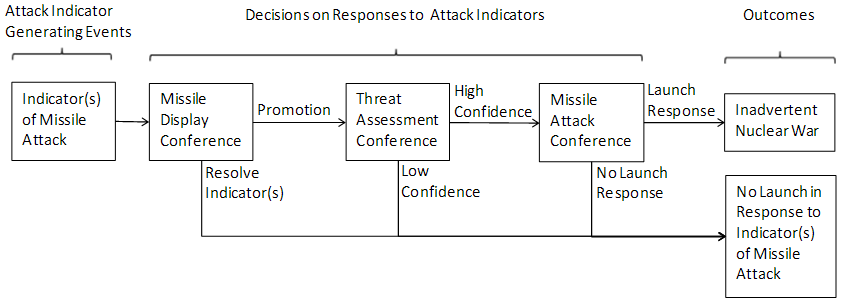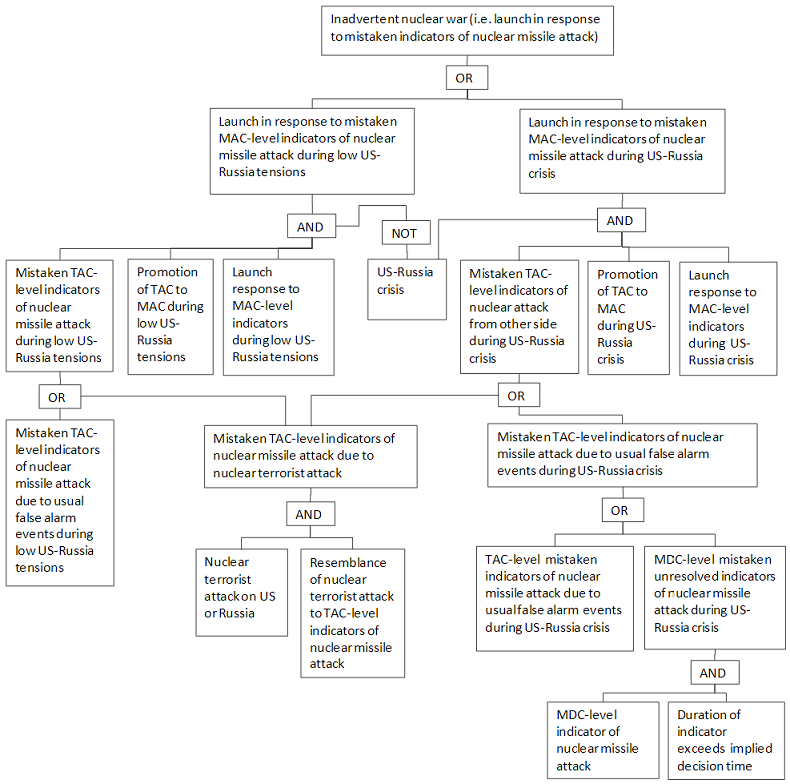
Series of steps to evaluate whether the initial event is an attack or a false alarm. Note this figure is for the US. The paper assumes that Russia's procedures are similar.
An analysis of the possibility that the US or Russia could mistakenly conclude it is under attack and launch nuclear weapons in what it believes to be a counterattack.
Anthony M. Barrett, Seth D. Baum, and Kelly R. Hostetler, 2013. Analyzing and reducing the risks of inadvertent nuclear war between the United States and Russia. Science and Global Security, vol. 21, no. 2, pages 106-133.
Pre-print: Click here to view a full pre-print of the article (pdf).
* Blog discussion at Global Catastrophic Risk Institute
Abstract:
This paper develops a mathematical modeling framework using fault trees and Poisson processes for analyzing the risks of inadvertent nuclear war from U.S. or Russian misinterpretation of false alarms in early warning systems, and for assessing the potential value of inadvertence risk reduction options. The model also uses publicly available information on early-warning systems, near-miss incidents, and other factors to estimate probabilities of a U.S.-Russia crisis, the rates of false alarms, and the probabilities that leaders will launch missiles in response to a false alarm. The paper discusses results, uncertainties, limitations, and policy implications.
Non-Technical Summary: pdf version
Background: Inadvertent Nuclear War
Inadvertent nuclear war as defined in this paper occurs when one nation mistakenly concludes that it is under attack and launches nuclear weapons in what it believes to be a counterattack. A US-Russia nuclear war would be a major global catastrophe since these countries still possess thousands of nuclear weapons. Despite the end of the Cold War, the risk remains. This paper develops a detailed mathematical "fault tree" model to analyze the ongoing risk of inadvertent US-Russia nuclear war.
The Fault Tree Model
A fault tree is a scheme for modeling events and conditions that could result in some final event. Here, the final event is inadvertent US-Russia nuclear war. Initial events could include research rockets, as in the 1995 Norwegian rocket incident, faulty computer chips, wild animal activity, and nuclear terrorist attacks. The nation that detects the initial event, US or Russia, then goes through decision procedures to evaluate the event and decide whether to launch nuclear weapons in response. The model takes data on the probabilities of initial events going through the decision procedures to calculate the probability of the final event. Different data is used during conditions of low or high US-Russia tensions. During high tensions, weapons launch is more likely because the initial event is more likely to be interpreted as a real attack instead of a false alarm.
Annual Probability of Inadvertent US-Russia Nuclear War
The paper calculates the annual probability of inadvertent US-Russia nuclear war, meaning the probability of the war occurring during the course of a year. While much remains uncertain, the paper finds that there may still be significant risk of inadvertent US-Russia nuclear war. This general finding holds even if there are fewer initial false alarm events than there were during the Cold War. The finding also holds even if inadvertent war could only occur during high tensions, although inadvertent war is found to be more likely if it could also occur during low tensions.
Options For Risk Reduction
The paper considers two options for reducing the risk of inadvertent US-Russia nuclear war. First, each nation's submarines with nuclear weapons could be moved further from the other's border, to give the other nation more time to decide if an initial event is a real submarine-launched attack or a false alarm. Second, the nations could lower their level of alert for part of the time, so that they will be less likely to conclude that an initial event is an attack. Both options were found to reduce the risk of inadvertent nuclear war. However, before recommending these options, further analysis is needed to assess the effects they have on other risks, including intentional (non-inadvertent) nuclear war.

Series of steps to evaluate whether the initial event is an attack or a false alarm. Note this figure is for the US. The paper assumes that Russia's procedures are similar.

The full fault tree.
Created 8 Jan 2013 * Updated 29 Jul 2013